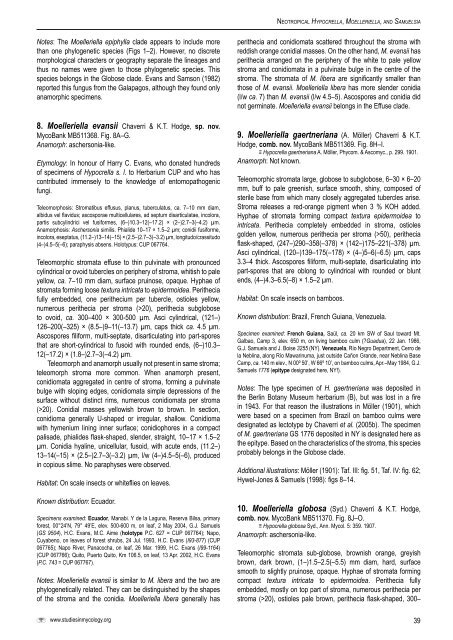Moelleriella, and Samuelsia - CBS
Moelleriella, and Samuelsia - CBS
Moelleriella, and Samuelsia - CBS
- No tags were found...
You also want an ePaper? Increase the reach of your titles
YUMPU automatically turns print PDFs into web optimized ePapers that Google loves.
Ne o t r o p i c a l Hy p o c r e l l a, Mo e l l e r i e l l a, a n d Sa m u e l s i aNotes: The <strong>Moelleriella</strong> epiphylla clade appears to include morethan one phylogenetic species (Figs 1–2). However, no discretemorphological characters or geography separate the lineages <strong>and</strong>thus no names were given to those phylogenetic species. Thisspecies belongs in the Globose clade. Evans <strong>and</strong> Samson (1982)reported this fungus from the Galapagos, although they found onlyanamorphic specimens.8. <strong>Moelleriella</strong> evansii Chaverri & K.T. Hodge, sp. nov.MycoBank MB511368. Fig. 8A–G.Anamorph: aschersonia-like.Etymology: In honour of Harry C. Evans, who donated hundredsof specimens of Hypocrella s. l. to Herbarium CUP <strong>and</strong> who hascontributed immensely to the knowledge of entomopathogenicfungi.Teleomorphosis: Stromatibus effusus, planus, tuberculatus, ca. 7–10 mm diam,albidus vel flavidus; ascosporae multicellulares, ad septum disarticulatae, incolora,partis subcylindrici vel fusiformes, (6–)10.3–12(–17.2) × (2–)2.7–3(–4.2) µm.Anamorphosis: Aschersonia similis. Phialide 10–17 × 1.5–2 µm; conidii fusiforme,incolora, eseptatus, (11.2–)13–14(–15) × (2.5–)2.7–3(–3.2) µm, longitudo/crassitudo(4–)4.5–5(–6); paraphysis absens. Holotypus: CUP 067764.Teleomorphic stromata effuse to thin pulvinate with pronouncedcylindrical or ovoid tubercles on periphery of stroma, whitish to paleyellow, ca. 7–10 mm diam, surface pruinose, opaque. Hyphae ofstromata forming loose textura intricata to epidermoidea. Peritheciafully embedded, one perithecium per tubercle, ostioles yellow,numerous perithecia per stroma (>20), perithecia subgloboseto ovoid, ca. 300–400 × 300-500 µm. Asci cylindrical, (121–)126–200(–325) × (8.5–)9–11(–13.7) µm, caps thick ca. 4.5 µm.Ascospores filiform, multi-septate, disarticulating into part-sporesthat are short-cylindrical to fusoid with rounded ends, (6–)10.3–12(–17.2) × (1.8–)2.7–3(–4.2) µm.Teleomorph <strong>and</strong> anamorph usually not present in same stroma;teleomorph stroma more common. When anamorph present,conidiomata aggregated in centre of stroma, forming a pulvinatebulge with sloping edges, conidiomata simple depressions of thesurface without distinct rims, numerous conidiomata per stroma(>20). Conidial masses yellowish brown to brown. In section,conidioma generally U-shaped or irregular, shallow. Conidiomawith hymenium lining inner surface; conidiophores in a compactpalisade, phialides flask-shaped, slender, straight, 10–17 × 1.5–2µm. Conidia hyaline, unicellular, fusoid, with acute ends, (11.2–)13–14(–15) × (2.5–)2.7–3(–3.2) µm, l/w (4–)4.5–5(–6), producedin copious slime. No paraphyses were observed.Habitat: On scale insects or whiteflies on leaves.Known distribution: Ecuador.Specimens examined: Ecuador, Manabi. Y de la Laguna, Reserva Bilsa, primaryforest, 00°24’N, 79° 49’E, elev. 500-600 m, on leaf, 2 May 2004, G.J. Samuels(GS 9504), H.C. Evans, M.C. Aime (holotype P.C. 627 = CUP 067764); Napo,Cuyabeno, on leaves of forest shrubs, 24 Jul. 1993, H.C. Evans (I93-877) (CUP067765); Napo River, Panacocha, on leaf, 26 Mar. 1999, H.C. Evans (I99-1164)(CUP 067766); Quito, Puerto Quito, Km 106.5, on leaf, 13 Apr. 2002, H.C. Evans(P.C. 743 = CUP 067767).Notes: <strong>Moelleriella</strong> evansii is similar to M. libera <strong>and</strong> the two arephylogenetically related. They can be distinguished by the shapesof the stroma <strong>and</strong> the conidia. <strong>Moelleriella</strong> libera generally haswww.studiesinmycology.orgperithecia <strong>and</strong> conidiomata scattered throughout the stroma withreddish orange conidial masses. On the other h<strong>and</strong>, M. evansii hasperithecia arranged on the periphery of the white to pale yellowstroma <strong>and</strong> conidiomata in a pulvinate bulge in the centre of thestroma. The stromata of M. libera are significantly smaller thanthose of M. evansii. <strong>Moelleriella</strong> libera has more slender conidia(l/w ca. 7) than M. evansii (l/w 4.5–5). Ascospores <strong>and</strong> conidia didnot germinate. <strong>Moelleriella</strong> evansii belongs in the Effuse clade.9. <strong>Moelleriella</strong> gaertneriana (A. Möller) Chaverri & K.T.Hodge, comb. nov. MycoBank MB511369. Fig. 8H–I.≡ Hypocrella gaertneriana A. Möller, Phycom. & Ascomyc., p. 299. 1901.Anamorph: Not known.Teleomorphic stromata large, globose to subglobose, 6–30 × 6–20mm, buff to pale greenish, surface smooth, shiny, composed ofsterile base from which many closely aggregated tubercles arise.Stroma releases a red-orange pigment when 3 % KOH added.Hyphae of stromata forming compact textura epidermoidea tointricata. Perithecia completely embedded in stroma, ostiolesgolden yellow, numerous perithecia per stroma (>50), peritheciaflask-shaped, (247–)290–358(–378) × (142–)175–221(–378) µm.Asci cylindrical, (120–)139–175(–178) × (4–)5–6(–6.5) µm, caps3.3–4 thick. Ascospores filiform, multi-septate, disarticulating intopart-spores that are oblong to cylindrical with rounded or bluntends, (4–)4.3–6.5(–8) × 1.5–2 µm.Habitat: On scale insects on bamboos.Known distribution: Brazil, French Guiana, Venezuela.Specimen examined: French Guiana, Saül, ca. 20 km SW of Saul toward Mt.Galbao, Camp 3, elev. 650 m, on living bamboo culm (?Guadua), 22 Jan. 1986,G.J. Samuels <strong>and</strong> J. Boise 3255 (NY). Venezuela, Río Negro Department, Cerro dela Neblina, along Río Mawarinuma, just outside Cañon Gr<strong>and</strong>e, near Neblina BaseCamp, ca. 140 m elev., N 00º 50’, W 66º 10’, on bamboo culms, Apr.–May 1984, G.J.Samuels 1776 (epitype designated here, NY!).Notes: The type specimen of H. gaertneriana was deposited inthe Berlin Botany Museum herbarium (B), but was lost in a firein 1943. For that reason the illustrations in Möller (1901), whichwere based on a specimen from Brazil on bamboo culms weredesignated as lectotype by Chaverri et al. (2005b). The specimenof M. gaertneriana GS 1776 deposited in NY is designated here asthe epitype. Based on the characteristics of the stroma, this speciesprobably belongs in the Globose clade.Additional illustrations: Möller (1901): Taf. III: fig. 51, Taf. IV: fig. 62;Hywel-Jones & Samuels (1998): figs 8–14.10. <strong>Moelleriella</strong> globosa (Syd.) Chaverri & K.T. Hodge,comb. nov. MycoBank MB511370. Fig. 8J–O.≡ Hypocrella globosa Syd., Ann. Mycol. 5: 359. 1907.Anamorph: aschersonia-like.Teleomorphic stromata sub-globose, brownish orange, greyishbrown, dark brown, (1–)1.5–2.5(–5.5) mm diam, hard, surfacesmooth to slightly pruinose, opaque. Hyphae of stromata formingcompact textura intricata to epidermoidea. Perithecia fullyembedded, mostly on top part of stroma, numerous perithecia perstroma (>20), ostioles pale brown, perithecia flask-shaped, 300–39
















